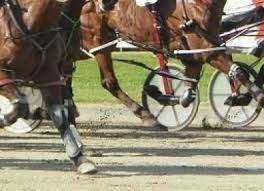Guelph, ON June 30, 2024 – On Canada Day long weekend, fire fighters from all over the province came to the University of Guelph to attend an intensive Large Animal Emergency Rescue (LAER) training program hosted by Equine Guelph.
Firefighters from Hamilton, Milton, Lucknow, Chatsworth, Caledon, Halton Hills, West Elgin, Ramara, Oakville and Essa Township participated in the two-and-a-half-day event, gaining essential skills for rescuing large animals during emergencies.
“Firefighters are very often the first responders called to the scene, whether it’s an overturned trailer on the highway, a horse stuck in the mud, or rescuing animals from a barn fire,” says Riley McGilloway, course co-lead instructor from Halton Hills Fire Department. “The value of having firefighter specific training is it allows firefighters to understand their roles and limitations at an emergency involving large animals. The overall goal of this course is to give firefighters a game plan of how they can complete a safe and successful rescue with tools we already have on the fire truck.”
“We are in our 10th year offering this important, specialized training,” says course facilitator, Dr. Susan Raymond. “Equine Guelph remains committed to enhancing large animal rescue capabilities through education and practical training. Our large animal emergency rescue program prioritizes the welfare and well-being of animals involved in incidents, while emphasizing the safety of those involved in rescue operations.”
Not all first responders have experience handling large animals, so the workshops always begin with training in horse behaviour & handler safety. The firefighters received hands-on experience with the University of Guelph’s BBRM teaching herd. They learned how to quickly make an emergency halter and lead a horse to safety as well as herd loose horses. For exercises that called for simulations of downed horses in tricky situations, a 600-pound, mannequin named ‘Rusti’ allowed the teams to formulate a plan and use specialized equipment to extricate him.
“The proper use of specialized equipment and positioning of webbing around the body of the animal is so important to having a positive outcome of lifting or dragging a large animal to safety,” says lead instructor Victor MacPherson, EBSP Rescue.

The teams worked with wide tow straps executing forward, backwards and sideways drags and assists depending on the mock situations they were presented with. All the while they were reminded of the kick zones and anatomy lessons learned that stressed a horse’s head and tail can never be used as handles. The crew were warned that even a calm-looking horse might react unexpectedly once released from a compromising situation. Participants learned how to use specialized reach tools, stop guides, and glides to secure and transport large animals to safety.
Dr. Chris Riley, Chair of the Department of Clinical Studies at the Ontario Veterinary College, was on hand to discuss veterinary roles in animal incidents and the importance of all responders working together utilizing the incident command system and being familiar with their roles ahead of time.
Firefighters discussed potential tactics for incidents involving commercial transport vehicles during a walk-through of a livestock hauler, kindly provided by Cleon Gingrich of Gemrich Transport in Fergus.
Teamwork, communication and safety were practiced in every simulated scenario including: downed horse in a trailer accident, horse caught up in a fence, fallen horse and rider incident, and barn fire evacuation.
“The course was a tremendous help, teaching how to approach and evacuate large animals efficiently, operate all sorts of different stall gates and doors and how to use an emergency halter in a barn fire scenario,” says course participant, Paulette Brassard, who is currently pre-service. “The chance to train with live horses was invaluable. I will most definitely recommend this class to others.”

Participant and assistant trainer Andrew Brassage from Milton Fire department says “After 24 years in the fire service, I have both taken and taught classes in Canada and the USA. I will say that this was a top tier class and one of the best training experiences of my life. The facilities and props are world class, as are the staff and instructors. I would highly recommend it for all fire service members from the biggest to the smallest departments that might deal with situations that would involve the rescue of horses and other farm animals.”
Equine Guelph thanks the supporters, facilitators, and participants of these important large animal emergency rescue workshops. A special thank you to: Chantal Mitchell Racing, Ellis Racing, Felix Marion Farrier Services, First Line Training Center, Flexineb, Gemrich Transport, Glenview Livestock Racing, Grand River Agricultural Society, Jonathan Drury Racing, Let it Ride Stable, Ontario Farm & Food Care Ontario, Ontario Livestock & Poultry Council, Pit Bull Stable, System Equine and Tony Beaton Racing.
A huge thank you also goes out to the Lead Trainers – Victor MacPherson & Riley McGilloway and assistant trainer Katherine Hoffman.
Many thanks to CTV for TV coverage of this event.
Participants must be a minimum of 18 years of age. First responders, pre-service, law enforcement, animal welfare officers, veterinarians, vet. technicians, emergency animal response teams, horse owners, livestock producers and associations are all encouraged to attain skills in large animal rescue.Delivered by Equine Guelph (University of Guelph), in the past decade, the LAER program has continued to grow and expand its offerings to a varied group. If you are interested in helping to build this program or would like to discuss offering this program in your area or to your members, please contact Susan Raymond at Equine Guelph. Courses can be offered on a cost-recovery basis, or through sponsorship, to communities/individuals who would like to expand the reach of this training program.
From Equine Guelph

 USA
USA Canada
Canada Australia
Australia New Zealand
New Zealand Europe
Europe UK / IRE
UK / IRE



